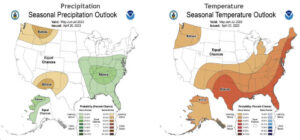This years winter may look drastically different than recent years because of El Niño. This winter will be the first in a few years to feel the effects of the phenomenon, which has a sizable impact on the weather during the coldest months of the year.
El Niño is one of three phases of the El Niño Southern Oscillation, which tracks water temperature changes in the equatorial Pacific Ocean that can have rippling effects on weather patterns around the globe. The El Niño phase occurs when these ocean temperatures are warmer than normal for an extended period.
This year’s El Niño began in June, is expected to be strong this winter and last at least into early next spring, according to NOAA’s Climate Prediction Center. El Niño’s cooler counterpart, La Niña, played a huge role in the past three winters across the US, keeping the South dry while parts of the West received a lot of much-needed snow.
One of the major reasons is the position of the jet stream, which often shifts south during an El Niño winter. This shift typically brings wetter and cooler weather to the South while the North becomes drier and warmer, according to NOAA. Because the jet stream is essentially a river of air that storms flow through, they can move across the South with increased frequency during an El Niño winter. More storms means more precipitation, typically from the southern Plains to the Southeast. This could be crucial for states like Texas, Louisiana and Mississippi plagued by drought.
